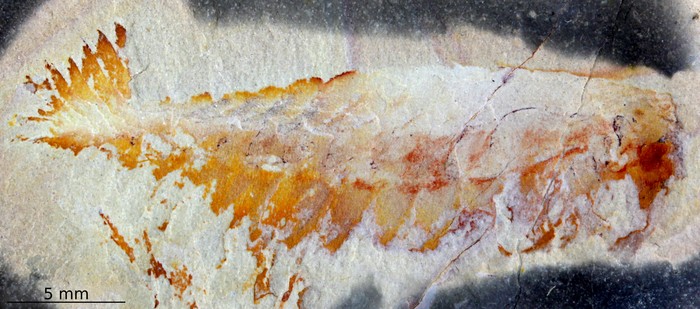Opabinia regalis was known as the only species of its genus, in addition to having a very strange morphology. Analysis of a fossil shows that she was not alone.
It’s a wonderful and bizarre paleontological discovery: by analyzing a fossil, a new species has been identified in one of the strangest now extinct genera in the animal world.
Until now, only one species was known in the now extinct genus Opabinia. Called Opabinia regalis, this deep-dwelling species was first documented in 1912 and then popularized by famed biologist Stephen Jay Gould. The fossils had been found in deposits dating from the Cambrian – located between −541 million and −485.4 million years before our era.
Each species has its particularities, but this one can easily be defined as not being “like the others”. Opabinia regalis had five eyes: two stalked pairs on the sides, and one in the center. Its body is that of a soft-bodied arthropod, measuring between 43 and 70 mm. In addition to the five eyes, there is a long trunk (which has no equivalent among Cambrian species), whose flexibility allowed it to reach the mouth. The trunk probably allowed him to feed, especially since there were thorns at the end.
Exactly a century after the discovery of this species, work published on February 9, 2022 documents a new species belonging to the genus Opabinia. Its name: Utaurora comosa.

“The Strangest Cambrian Wonder Is No Longer Alone”
The fossils ofUtaurora comosa were originally found in 2008, in Cambrian sediments 500 million years old. The species was then classified as belonging to the genus Radiodonta, which was among the most dominant, in number, in the Cambrian period. But that was a mistake, and biologist Stephen Pates guessed as soon as he saw a specimen — which he said didn’t quite resemble the genus Radiodonta.

This is what led him, with his team, to launch a study using the latest established methods of phylogenetics – an approach that traces the genealogical tree of species. All the analyzes and morphological tests carried out confirmed thatUtaurora comosa does belong to the Opabinia. A lot of specimens of the genus Radiodonta have also been discovered since 2008, which allows scientists to better understand this genus. In fact, the differences of this particular specimen became much more visible. As a result, the analyzes made it possible to determine a proximity of 68% with the Opabinia regalisbut only 0.04% with the Radiodonta, which leaves little room for doubt.
This means that there are now two identified species of the genus Opabinia which, as a genus (a set of species) remains unique. ” The Strangest Cambrian Wonder Is No Longer Alone write the scientists in their study.
